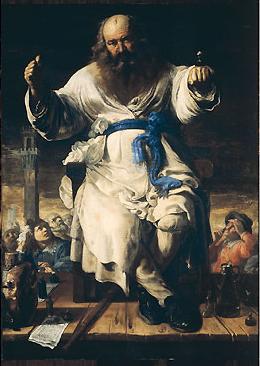The Charlatan (Mei) on:
[Wikipedia]
[Google]
[Amazon]
 ''The Charlatan'' (Italian ''Il Ciarlatano'') is a large 1656 satirical painting by the Italian
''The Charlatan'' (Italian ''Il Ciarlatano'') is a large 1656 satirical painting by the Italian
 ''The Charlatan'' (Italian ''Il Ciarlatano'') is a large 1656 satirical painting by the Italian
''The Charlatan'' (Italian ''Il Ciarlatano'') is a large 1656 satirical painting by the Italian Baroque
The Baroque (, ; ) is a style of architecture, music, dance, painting, sculpture, poetry, and other arts that flourished in Europe from the early 17th century until the 1750s. In the territories of the Spanish and Portuguese empires including t ...
artist Bernardino Mei. It shows an aged charlatan seated on an armchair resting on a trestle
ATLAS-I (Air Force Weapons Lab Transmission-Line Aircraft Simulator), better known as Trestle, was a unique electromagnetic pulse (EMP) generation and testing apparatus built between 1972 and 1980 during the Cold War at Sandia National Laborato ...
stage in the ''Piazza del Campo
Piazza del Campo is the main public space of the historic center of Siena, Tuscany, Italy and is regarded as one of Europe's greatest medieval squares. It is renowned worldwide for its beauty and architectural integrity. The Palazzo Pubblico and i ...
'', the main square of the Tuscan town of Siena. He holds in his left-hand the tools of his trade; vials and remedies, with pitchers and an invoice reading ''L'olio de filosofi di Straccione'' (Straccione's Philosopher's oil) lying on the cheap timbre below him. The man is hefty and dressed in old, filthy clothes -he bears a dirty white robe with a blue sash, white leggings and heavy black shoes- and an unkempt beard; Bernardino has unflatteringly portrayed him as a mixture of a second rate Old Testament
The Old Testament (often abbreviated OT) is the first division of the Christian biblical canon, which is based primarily upon the 24 books of the Hebrew Bible or Tanakh, a collection of ancient religious Hebrew writings by the Israelites. The ...
prophet, tattered alchemical philosopher, and the forbidding Roman god Saturn
Saturn is the sixth planet from the Sun and the second-largest in the Solar System, after Jupiter. It is a gas giant with an average radius of about nine and a half times that of Earth. It has only one-eighth the average density of Earth; h ...
.
The old man's simple minded audience look up at him with a sense of wonder and awe; one, dressed in a rose coloured gown is so overcome that he seems about to faint and reaches for a sniff of a remedy to regain strength. Mei has abandoned any pretence of perspective, the charlatan is several times larger than the member of his audience, and is seemingly suspended in the air, floating above the rabble below.Gentilcore, 28 He looks out directly at the viewer, offering one of his potions in his raised right hand, with his head bowed in faux humility.
Mei utilises mostly dark tones, and although the main figure is hugely imposing to the viewer, the overall mood is sombre and melancholy. Although alchemists were still popular with the middle classes at the time the painting was created, they were maligned figures in the eyes of the educated.Gentilcore, 29
The work was popular as a print in the 18th century, however the relevance of its message was lost soon after.
Notes
Sources
* Gambaccini Piero. ''Mountebanks and Medicasters: A History of Italian Charlatans from the Middle Ages to the Present''. McFarland, 2004. * Gentilcore, David. ''Medical Charlatanism in Early Modern Italy''. New York: Oxford University Press, 2006. {{DEFAULTSORT:Charlatan 1656 paintings